unit6SectionB导学案
- 格式:doc
- 大小:46.50 KB
- 文档页数:4

人教版英语七年级上册教案:Unit6 SectionB(2a-2c)Unit6 SectionB(2a-2c)教案【教材版本与册数】新目标人教版七年级上册【单元名称】Unit 6 Do you like bananas?【课时】Section B 2a-2c(第4课时)【课型】Reading(阅读课)教材分析【本单元话题】喜欢和不喜欢(like and dislike)【本单元重点掌握目标】行为动词在一般现在时句子中的使用,应该是上一个单元内容的延伸,通过本单元的教学,学生应初步掌握行为动词一般现在时的肯定句、否定句、特殊疑问句、一般疑问句的构成以及简单的回答和表示食物的可数名词和不可数名词。
【教材内容坼分分析】本单元Section A主要是谈论喜欢和不喜欢(like and dislike),Section B进一步拓展了此话题,按照“听力输入--阅读训练--由读促写”的过程逐层递进。
【通过本单元的学习学生需掌握的综合技能】训练学生的听、说、读、写四项基本技能,学会询问对方与了解别人喜欢与不喜欢的食物,学会谈论自己与他人早、中、晚餐喜爱吃的食物,为其今后能在交际中恰当地表达自己的情感、灵活运用已经学过的常用功能项目、进一步学习并掌握新的语言功能奠定坚实的基础。
第 2 页第 3 页DEL C2 获取新知Step2Reading1. T: Well, let’s see some sports star’s eating habits. Cindy Smith is avolleyball star. What does she like for breakfast, lunch and dinner? Doesshe eat ice-cream? Now let’s r ead the magazine article about Cindy Smith.First, read the article and circle the food words.(Ss read the article and circle the food words quickly.)2.Read the article and fill in the blanks.3. We know Cindy has healthy eating habits. What food does she like? Whatfood doesn’t she like? Read the article and write five sentences aboutCindy’s eating habits. e.g.Cindy likes fruit for breakfast.1.带着问题阅读文章,寻找答案2.再读文章,完成练习学生能够自主阅读文章并寻找答案第 4 页(注意运用句型:Cindy likes … for … 或Cindy doesn’t like/eat … for …)4. Let some Ss read their sentences to the class.5. Then finish 2c.Write five sentences about Ci ndy’s eating habits.Cindy likes healthy food.1. Cindy ___loves fruit.____________________________2. She ____likes oranges and bananas._____________________________3. She _____likes salad for lunch.____________________________4. Cindy doesn’t ___like hamburgers for dinner._____________________5. She doesn’t ___eat ice-cream after dinner._______________________Step3 Language points 1. Sports star eats well!句中的well用作副词,意为“好”,用来修饰动词eat,意为“吃得好”。
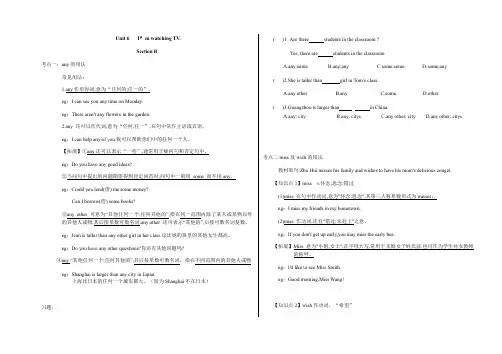
Unit 6 I’m watching TV.Section B考点一:any的用法常见用法:1.any作形容词,意为“任何的;任一的”.eg:I can see you any time on Monday.eg:There aren't any flowers in the garden.2.any 还可以作代词,意为“任何;任一”,在句中常作主语或宾语。
eg:I can help any of you.我可以帮助你们中的任何一个人。
【拓展】①any还可以表示“一些”,通常用于疑问句和否定句中。
eg:Do you have any good ideas?②当问句中提出的问题期望得到肯定回答时,问句中一般用some 而不用any。
eg:Could you lend(借) me some money?Can I borrow(借) some books?③any other 可意为“其他任何一个;任何其他的”,指在同一范围内除了某人或某物以外的其他人或物,其后接单数可数名词;any other 还可表示“其他的”,后接可数名词复数。
eg:Jean is taller than any other girl in her class.琼比她的班里的其他女生都高。
eg:Do you have any other questions?你还有其他问题吗?④any “其他任何一个;任何其他的”,其后接单数可数名词,指在不同范围内的其他人或物eg:Shanghai is larger than any city in Japan.上海比日本的任何一个城市都大。
(因为Shanghai不在日本)习题:( )1.-Are there students in the classroom ?-Yes, there are students in the classroomA.any;someB.any;anyC.some;someD.some;any( )2.She is taller than girl in Tom’s class.A.any otherB.anyC.some.D.other( )3.Guangzhou is larger than in China.A.any; cityB.any; citysC.any other; cityD.any other; citys考点二:miss及wish的用法教材原句:Zhu Hui misses his family and wishes to have his mom's delicious zongzi.【知识点1】miss v.怀念;思念;错过(1)miss 在句中作动词,意为"怀念;思念",其第三人称单数形式为misses。
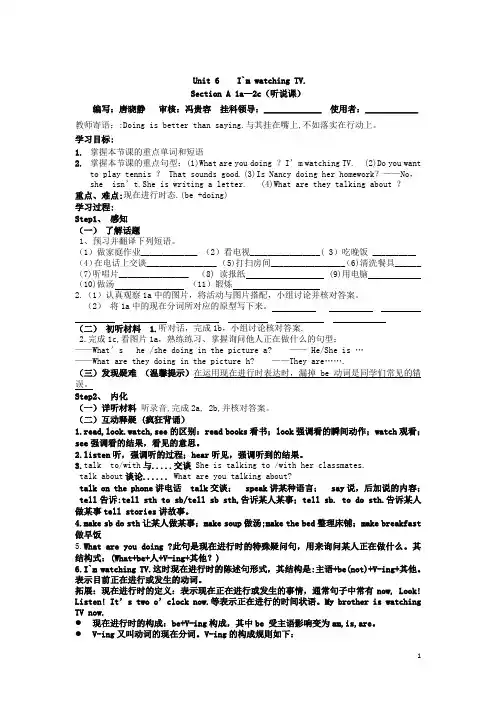
Unit 6 I`m watching TV.Section A 1a—2c(听说课)编写:唐晓静审核:冯贵容挂科领导:_____________ 使用者:____________ 教师寄语::Doing is better than saying.与其挂在嘴上,不如落实在行动上。
学习目标:1.掌握本节课的重点单词和短语2.掌握本节课的重点句型:(1)What are you doing ?I’m watching TV. (2)Do you wantto play tennis ? That sounds good.(3)Is Nancy doing her homework?——No,she isn’t.She is writing a letter. (4)What are they talking about ?重点、难点:现在进行时态.(be +doing)学习过程:Step1、感知(一)了解话题1、预习并翻译下列短语。
(1)做家庭作业_____________ (2)看电视________________( 3)吃晚饭 __________(4)在电话上交谈________________ (5)打扫房间_________________(6)清洗餐具______(7)听唱片________________ (8) 读报纸 (9)用电脑(10)做汤(11)锻炼2.(1)认真观察1a中的图片,将活动与图片搭配,小组讨论并核对答案。
(2)将1a中的现在分词所对应的原型写下来。
(二)初听材料 1.听对话,完成1b,小组讨论核对答案.2.完成1c,看图片1a,熟练练习、掌握询问他人正在做什么的句型:——What’s he /she doing in the picture a? —— He/She is …——What are they doing in the picture h? ——They are…….(三)发现疑难(温馨提示)在运用现在进行时表达时,漏掉be动词是同学们常见的错误。

第三课时Section B(1a~1e)01基础过关Ⅰ.根据句意及首字母提示填写单词。
1.How smart Jim is!He can speak three l________-English,Chinese and Russian. 2.Zhu Ling wasn't happy though she got good g________ in the test.3.You should often e________ if you want to be healthier.4.Her classmate wants to join the school basketball t________ next week.5.We are all Chinese,but Bob,Frank and Linda are from f________ countries. Ⅱ.用括号内所给单词的适当形式填空。
6.Does Henry look much ________(healthy) than his brother?7.Now Jack studies Chinese ________(real) hard.8.Your sister's plan sounds very ________(interest).9.Both Alice and Helen ________ (watch) a movie tomorrow evening.10.Mr.Green ________ (climb) the mountain with his friends next week.Ⅲ.单项选择。
( )11.—What is her New Year's ________?—She's going to study a lot.A.subject B.educationC.exercise D.resolution( )12.Lily loves music.She is going to ________.A.play sportsB.exercise moreC.eat more vegetablesD.take guitar lessons( )13.Chengdu ________ a beautiful place to live in.A.sounds B.sound likeC.sounds like D.sounds as( )14.—________ are you going to be a pianist?—I'm going to practice the piano every day.A.How B.WhyC.What D.Where( )15.—I'm going to join a soccer club to practice soccer next year.—________.A.No problem B.Sounds greatC.Thank you D.Have a good dayⅣ.根据汉语意思完成句子,每空一词。

课题:Unit 6 I’m going to study computer science.第四课时Section B ( 3a-Self check)学习目标:1、重点单词own (adj.&pron.)自己的;本人的;personal(adj.)个人的;私人的;relationship(n.)关系;联系2、重点词组get more exercise 做更多运动;physical health 身体健康;computer science计算机科学;study there for four days在那里学习四天3、重点句式(1). Resolutions are promises to yourself.决心就是对自己的承诺。
(2). They may help to make you a better person and to make your life easier.他们将会帮助你使你更完美,使你的生活更容易。
(3).That sounds cool.那听起来很酷。
(4).—Where are you going to study?你打算去哪里学习?—In Hefei.I’m going to study there for four days.合肥。
我打算去那里学习四天。
重点难点:重点1) 能够综合运用一般将来时态及所给的提示词来完成阅读填空的任务。
2)能够综合运用所学的知识来学习写作自己的新年决心。
难点能够综合运用所学的知识来学习写作自己的新年决心。
导学设计:1.make的用法【归纳】(1) make用作使役动词,意为“______”,①后接不定式的复合结构作宾语时,不定式不能带______。
例如:他把他妹妹弄哭了。
He _____ his sister____.。
②接_____作宾语补足语。
例如:我们会尽一切努力使你幸福。
We’ll do our best to ____ ____ ______.(2) 用于make it。
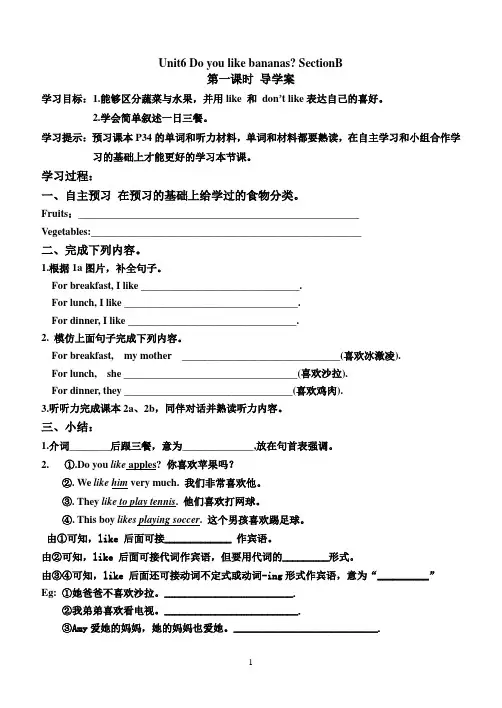
Unit6 Do you like bananas? SectionB第一课时导学案学习目标:1.能够区分蔬菜与水果,并用like 和don’t like表达自己的喜好。
2.学会简单叙述一日三餐。
学习提示:预习课本P34的单词和听力材料,单词和材料都要熟读,在自主学习和小组合作学习的基础上才能更好的学习本节课。
学习过程:一、自主预习在预习的基础上给学过的食物分类。
Fruits:_______________________________________________________Vegetables:_____________________________________________________二、完成下列内容。
1.根据1a图片,补全句子。
For breakfast, I like _______________________________.For lunch, I like __________________________________.For dinner, I like _________________________________.2. 模仿上面句子完成下列内容。
For breakfast, my mother _______________________________(喜欢冰激凌).For lunch, she __________________________________(喜欢沙拉).For dinner, they _________________________________(喜欢鸡肉).3.听听力完成课本2a、2b,同伴对话并熟读听力内容。
三、小结:1.介词________后跟三餐,意为______________,放在句首表强调。
2. ①.Do you like apples? 你喜欢苹果吗?②. We like him very much. 我们非常喜欢他。
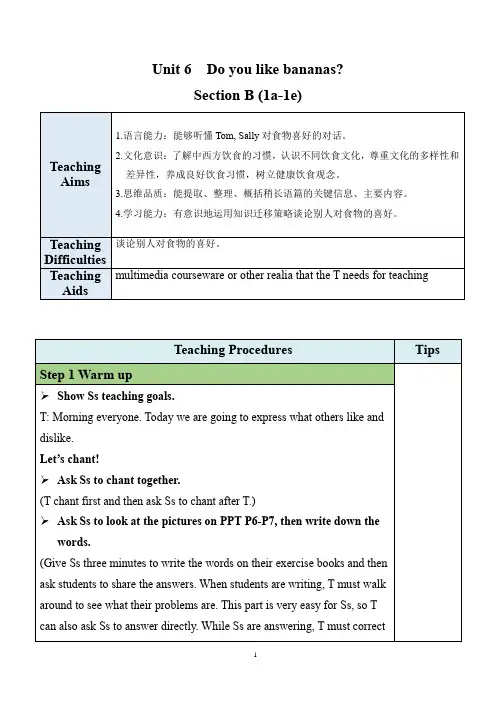
Unit 6 Do you like bananas?Section B (1a-1e)Unit 6 Do you like bananas?Section B (2a-2c)➢Ask Ss to write more healthy food and unhealthy food.Answers will vary.While-readingFirst Reading➢Reading Tip 1: PredictingT asks Ss to look at the title and pictures in 2b, try to predict: What's the article about?(T tells Ss what predict is: to have a guess. Any answer is OK here. Ss can tell the reason why they guess so.)Second Reading➢Reading Tip 2: scanningAsk Ss to scan the passage and complete the thinking map.➢Reading Tip 3: ScanningAsk Ss to judge which sentence is right and which sentence is wrong according to the passage.Answers: 1. F 2. F 3. T 4. T 5. TThird Reading➢Reading Tip 4: RetellingT asks Ss to retell the passage.(T can use the table above and give some clues to help Ss retell. T can say the first words of the sentences or use transitional words or questions to remind them of the next sentence if students forget. There will be somegrammatical mistakes when they are retelling, so teachers must use some transitional words to connect the sentences together, or to correct their pronunciations.)2b➢Ask Ss to read the magazine article and circle the food words.➢T ask Ss to write down the food that Cindy likes for meals and David likes for meals.T: Just now you have circled all the words about food. What does Cindy like for breakfast, lunch and dinner? What does David like for breakfast, lunch and dinner? Now write B for breakfast, L for lunch and D for dinner after the words.➢Let each S take out a piece of paper. Show Ss PPT P18 and ask them to write down the Chinese translation for each phrase.2c➢Ask Ss to write down five sentences about Cindy’s eating habits. While Ss are completing 2c, walk around the room and look at the sentence of different Ss. Choose sentences in which there are common errors, and write these sentences on the board. Then have Ss work in pairs to find the errors and suggest corrections. Elicit from Ss how to correct the sentences, and make the corrections on the board.Answers will vary.Post-reading➢Optional choice: Divide Ss into groups of four. Ask them to discuss what they like to eat for each meal. T can encourage Ss to say more about their preferences, e.g. I like ... but I don’t like ..., I always / never have ... for ... (T can write these sentences on the board if necessary).Unit 6 Do you like bananas? Section B (3a-Self Check)Exercise 1➢Ask Ss to write the plural forms of the words in the box on the left, then put them into the correct columns.Answers 1:Exercise 2➢First, ask Ss to choose a topic (i.e. the food / sports / colors they like or dislike), then let them write five sentences for that topic. Answers will vary.Exercise 3➢Tell Ss that they need to think about the food / sports / colors their parents like and write five sentences.Answers will vary.(T can encourage Ss to correct each other’s sentences first, then pick some Ss to read their answers to the whole class. )。

Section B 导学案一.Learning aims学习预定车票和房间的交际用语和术语二.New words预定______ 冰箱 _________ 宾馆 _________标准的 __________ 空调系统 _____________人 ______ 舒服的安逸的__________ 条件状况_________电影院 _______ 卧铺_______ 预定________三.Important phrases1.hard sleeper ____________2.soft sleeper___________3.whichkind____________4.on March 13th____________ 5.whatabout________=__________ 6.pay for________7.make a room reservation____________ 8.see the mountains clearly_____________9.a standard roomwith two single beds_________________10.one room with one singlebed__________11book的含义_______,_________11.hard 的含义________,________,______12.一张···的票____________13.想要做某事________,_________,___________14.到达________,________,__________15.价格为145元的硬卧__________________16.付钱_______ 17.询问物体价钱的句式______________________,____________________18.对物体的数量提问用_______,______,对时间提问用_______,_______ 对价钱提问用.__________________________ 19.计划停留________________ 20.标准间__________________四.Emphasis sentences1.I`d like to book some tickets to Mount Tai on March 13th.我想预定三月十三日去泰山的票。
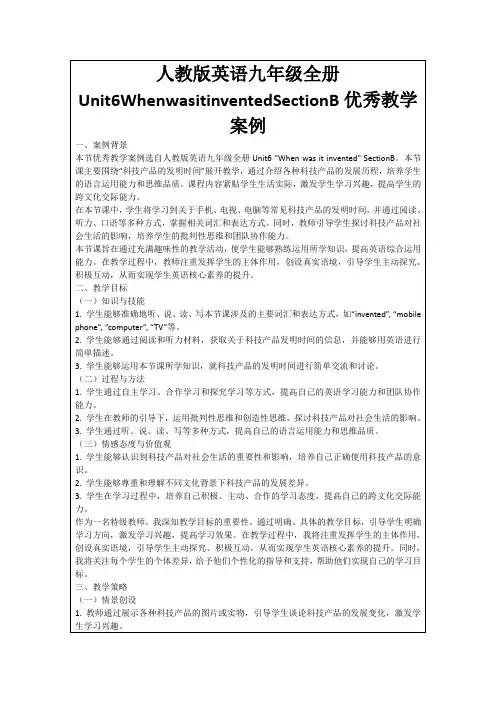
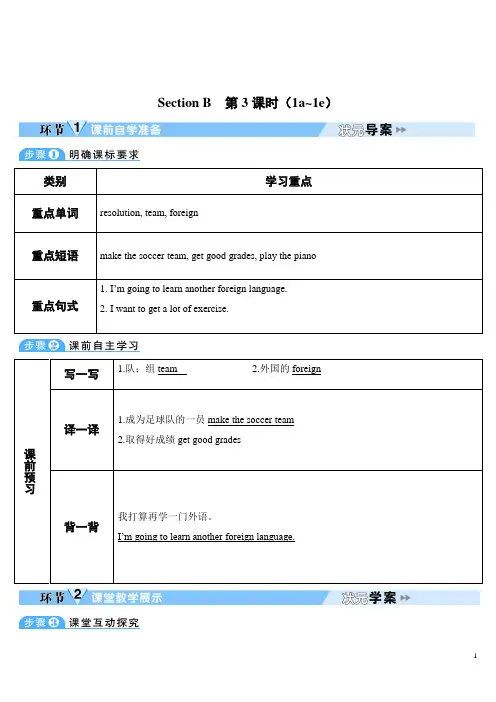
Section B 第3课时(1a~1e)类别学习重点重点单词resolution, team, foreign重点短语make the soccer team, get good grades, play the piano重点句式1. I’m going to learn another foreign language.2. I want to get a lot of exercise.课前预习写一写 1.队;组team 2.外国的foreign 译一译1.成为足球队的一员make the soccer team2.取得好成绩get good grades背一背我打算再学一门外语。
I’m going to learn another foreign language.It’s not easy to master a foreign language.活学活练1.—I am going to learn the piano when I grow up. —That sounds A a good idea.A. likeB. asC. aboutD. of2.—Is Mr. Brown living here?—No, he moved C last week.A.to anywhere quietB. somewhere quietC.to somewhere quietD.to quiet somewhere3.明年你的爸爸打算干什么?(汉译英)What is your father going to do next year?4.我不打算学另外一种外语。
(汉译英)I’m not going to stu dy a foreign language.布置作业:教师引导学生课后完成本课时对应练习,并预习下一课时内容。
教学反思本课时由新年到来,人们制定新年计划入手,让学生谈谈自己的新年计划,锻炼学生的口语表达能力;听说训练也让学生更熟练地掌握了语言交际用语;小结训练使语言目标得以强化。

Section B 2a-2e Part1: Analysis of the teaching materials: 2a-2e 以“New Year’s resolutions ”为主线,以贴近现实生活的resolutions 为话题展开阅读活动,阅读语篇介绍了resolutions 的定义、种类、特性等,读后设计了匹配段落大意、将句子放回原文、根据短文内容回答问题、用文中出现的重点词组造句等任务链活动,旨在帮助学生在掌握语篇信息的同时,发展相应的阅读技能,提升阅读策略。
旨在帮助学生在掌握语篇信息的同时,发展相应的阅读技能,提升阅读策略。
Part2: Intelligence analysis: 孩子们已经有一定的英语储备了,对所学的句型已经有了一定的了解,需要做的就是培养孩子良好的学习习惯,从而使学生的阅读理解能力得到培养和提高,结合前面所学知识,为孩子提供更多的机会和平台让学生练习所学的句型,在具体的语境中掌握更多的词汇,理解重难点词汇,使孩子们的听说读写能力得到全面提高。
一、Teaching aims :1. Language goals :1) Master the following words :question, meaning, discuss, promise, beginning, write down, physical, themselves, have to do with; self-improvement, take up, hobby, weekly, schoolwork 2) Master the following drills :① ─What are you going to do next year? ─I’m going to take guitar lessons. ② Many resolutions have to do with self-improvement. ③ They’re going to take up a hobby like painting. ④ Sometimes the resolutions may be too difficult to keep. 2. Motion objects :每个人都有自己的梦想和对未来的打算,对于将来想要从事的职业也充满了憧憬。
Unit 6 I'm going to study computer science?Section B1 (1a-1e)【学习目标】1.理解并掌握下列词汇及短语:New words: resolution,team,foreign,Key phrases: make a New Year's resolution, play the piano,make the soccer team,get good grades,eat healthier food,get lots of exercise,sound like 2.理解并掌握下列重点句子:(1)What are you going to do next year?Well,I'm going to take guitar lessons. I really love music.(2)Sounds interesting. I'm going to learn another foreign language.Are you?Great!But foreign languages are not for me.(3)I want to be a teacher. How are you going to do that?Well,I'm going to study hard and get good grades. Sounds like a good plan. I want to get a lot of exercise.3.Grammar: 进一步熟练掌握be going to结构的用法。
4. 能听懂用be going to结构谈论未来打算的对话,并能用该结构谈论未来的打算。
5. 通过谈论未来的打算,学会给自己制定目标,并能为之付出努力。
【学习重难点】1. The target language.2. Talk about plans and preparations you make for achievement of your future dreams.【课前预习】Ⅰ预习44页的1a,根据图片和文字信息,New Year’s resolutions的汉语意思是。
Unit 6 I’m watching TVSection B 2a-Self Check学习目标:1.培养学生的阅读能力;2.继续学习现在进行时的用法。
自主学习单词P125 race----Laura看英语,说汉语study host the United States Americanmiss young child (复数children) wishstill delicious any otherliving room dragon Dragon Boat Festival Dragon Boat races 看汉语,说英语学习东道主美国美国人想念年轻的儿童希望仍然美味可口的任一的另外的客厅龙端午节龙舟比赛把下列短语译成汉语making zongzi _____________________reading a story to her young children ______________________watching the boat races on TV ______________________________watching a soccer game on TV______________________________talking on the phone to his cousin __________________________2a Look at the clocks and make up dialogues.(合作学习)1)A : What time is it in Beijing?B : It’s eight o’clock in the morning2)A: What time is it in Tokyo?B: It’s ________ o’clock in the ___________.3)A: What time is it in New York?B: It’s ________ o’clock in the ___________4)A: What time is it in Sydney?B: It’s __________ o’clock in the __________ .2b Read the TV report and answer the questions. 阅读指导1.先看文章中的动词词汇,注意这些重点词汇。
Unit6 SectionB知识讲解1. in the end 最后;最终(1)at the end of...后接地点名词时,表示"在……尽头";后接表示时间的名词时,表示"在……结束时"。
(2)by the end of...意为"在……以前;到……为止",常用于将来时态或过去完成时态的句子中。
2. Canadian adj.加拿大的;加拿大的Canada(加拿大) Canadian (加拿大人)Australia (澳大利亚) Australian (澳大利亚人)America (美国;美洲) American (美国人;美洲人)3. divide...into把……分开其被动结构为be divided into,意为"被分为……"。
divide 及物动词,意为"分开;分散",指把整体分成若干部分。
4. encourage sb. to do sth. 鼓励某人做某事encourage sb. in sth. 意为"在……方面助长某人的某种行为/鼓励某人"。
5. at a low price 以低价low形容词,意为"低的"。
6. translate /træns’leɪt/ v. 翻译translate... into ...意为"把……翻译成……",既可用于主动语态中,也可用于被动语态中。
专题练习一、单项选择1.—Why do you ________ Liu Hulan?—Because she is a great heroine.A.look like B.look down on C.look over D.look up to 2.To encourage students to discuss in class, the teacher divided the class ________ several groups.A.into B.with C.for D.by3.We should ________ knowledge ________ practice.A.connect, with B.divide, into C.translate, into D.deal, with4.Micheal Jackson is called King of Pop, and people all over the world _______ him. A.look straight at B.look up to C.look down upon 5.Many foreign students came to our school last week, including three________andfive________.A.Germen; Canadian B.Germans; CanadiansC.Germen; Canadians D.Germans; Canadian二、完型填空What do you need for an invention to be a success?To begin with, good timing is very 6 . You can have a good idea which the public doesn’t want yet. Take Giovanni Caselli as an example. He invented the first fax machine in the 1860s. Though the quality was excellent, his invention quickly 7 . The fax machine did not become a necessary piece of equipment in every office until the 1980s.Money also helps. The Frenchman Denis Papin had the idea for a steam engine almost a hundred years before James Watt was born. Denis never had enough money to 8 one.You also need to be patient. It took scientists nearly eighty years to invent a light bulb.9 , you shouldn’t be too slow. In the 1870s, Elisha Gray developed plans for a telephone. Gray saw it only as “a beautiful toy”. When he finally sent details of his invention to the Patent Office (专利局) on February 14th, 1876, it was too 10 . Almost the same designs had arrived just two hours earlier. The young man who sent them was Alexander Graham Bell. He is remembered as the inventor of the telephone.Of course what you really need is a wonderful idea. If you haven’t got one, a walk in the countryside and a careful look at 11 can help. The Swiss scientist, George deMestral, had the idea for V elcro (粘扣) when he found his clothes covered in sticky seed pods after a walk in the countryside.6.A.interesting B.important C.personal D.satisfying 7.A.died B.improved C.spread D.appeared 8.A.deliver B.repair C.use D.build 9.A.However B.Instead C.So far D.At last 10.A.modern B.difficult C.late D.old 11.A.society B.nature C.pictures D.advertisements三、阅读单选One of the main problems in cities is traffic congestion (堵塞). The main reason is that we are not expanding (扩展) our transportation systems fast enough to meet the ever-increasing demands (需求). One solution is to create a new type of transportation that doesn’t rely on (依赖) roads.In the last century, planes and cars changed the way we lived. Cars have allowed us to move farther. Planes have cut travel time to faraway places. At the beginning of a new century, we may see the realization of a century-old dream---the mix of cars and planes---the flying cars. You might have heard news about flying cars before. The technology to make them safe and easy to fly may finally be here. With progress in lightweight material, computer models and no-man control, the dream is very close to becoming real.Car maker Moller went public with the Skycar M400 in 2011. It is the first car that can take off and land straight. The four-seat-Skycar is powered by eight engines (引擎). The cost of the car is about $1million at first, but when it begins to be produced in large amounts, that price could come down to as low as $60,000.The latest flying car CityHawk is said to be tested between 2021 and 2022. It is similar to the Skycar except for its power source. The important difference lies in the power fans that seem much quieter on the road. The CityHawk is as large as a middle-sized car. It could be used as an air taxi for news collection and traffic control.The popularity of flying cars could be very exciting or very scary (令人害怕的),depending on how you see it. With proper rules, they could be the answer to our ever-heavier traffic pressure.12.According to the first paragraph, the new type of transportation should be used to_______.A.improve the speed of cars B.solve traffic congestion C.increase people’s demands D.replace the present transportation system13.The writer mentions two kinds of flying cars to ________.A.show the importance of flying cars B.explain how flying cars work C.encourage people to buy flying cars D.show flying cars are coming to us 14.What’s the difference between the Skycar and the CityHawk?A.The Skycar has fewer seats.B.The Skycar is more expensive.C.The CityHawk is much smaller.D.The CityHawk makes less noise.15.Which of the following shows the structure of the passage?A.B.C.D.16.We can infer from the text that the writer feels ________ about the future of flying cars. A.doubtful B.hopeful C.negative D.worried四、用所给单词的正确形式填空17.A true friend can help you get out of ________ (sad) when you’re unhappy.18.Our great leader Deng Xiaoping passed away in his ________ (90).19.Our school sports meeting was ________ (success) held two weeks ago.20.Make careful ________ (choose) before taking action, please.21.Don’t worry. I have made much ________ (进步) in learning English.五、完成句子22.今天上午他拿错了伞。
Unit6 SectionB(3a-Self Check)教案【教材版本与册数】新目标人教版八年级上册【单元名称】Unit6 I’m going to study computer science.【课时】SectionB 3a-Self Check (第5课时)【课型】Writing ( 写作课)教材分析本课时内容是人教版新目标初中英语教材8上Unit 6第5课时,该单元话题是“Life goals”, 功能是“Talk about pfuture intentions",此节课型定位为以话题为核心的“写作课型”。
本单元Section B写作课部分在前面听说读的基础上,让学生在语言技能上通过复习词汇和操练重点句型,为写作做好铺垫。
从3a填词到3c写句子,再到3c完整语篇输出的活动设计,由易到难,循序渐进,符合学生写作发展和对事物的认知规律。
在策略上,通过提供材料并仿照练习,让学生用所学的目标语言来描述事物或事件并表达一定的思想,展开对计划或者愿望的写作,并且要培养学生的写作技能。
在情感态度上,通过活动4对该话题展开深入讨论,提升高度,规划自己生活的城市,增进学生了解家乡、热爱家乡的情感。
语言知识目标:1.通过教师复习、整合整个单元知识要点,形成体系。
并学习三个新单词own, personal, relationship学习能力:2.能够综合运用所学的知识来学习写作自己的新年决心。
1 / 6第 1 页教学目标 3.养成好的作文习惯,学习作文技能。
学习策略:4.通过完成Self check的中练习题来全面复习一般将来时态的用法。
情感态度价值观目标:通过学习这一课,引导学生确立理想职业,并为之奋斗,做坚持梦想的人。
教学重难点教学重点:1.复习本单元目标词汇及句型。
2.学会写作:学习写作技巧,语言组织能力。
教学难点:1.对学生写作能力及技巧的培养。
2.运用want to do/be going to do 表达将来的打算。
正阳县育才外国语学校:王眉
Unit 6 Our Local Area
Topic 1 Is there a computer in your study ?
Section B 1a---3
课型:新授课时间:2013.3 主讲:王眉
导学目标:
学习内容1) 词汇:lamp clock wall table key put put away door window under…
2)句子:What’s on your desk?
There is a lamp, a computer, some books and so on.
重难点: 1.There be…句型
2.正确的使用介词短语描述物品的位置
导学方案
Step 1.课前复习:
根据Section A 所学知识,用be动词的适当形式填空。
1. There a pen in my hand.
2. There 16 girls in our class.
3. There some juice in the glass.
4. There a pen and some books in my schoolbag.
5. there a study on the second floor ?
6. there any apples in the kitchen ?
***There be句型的谓语口诀:
There be句型可译“有”,be动词跟着名词走。
名词单数不可数,当用is记清楚。
如果名词是复数,用are一定要记住。
出现并列主语特殊记,就近原则用仔细。
(拓展:There be句型对划线部分提问口诀:
提问主语较简单,需用“What’s/Who’s+地点”
提问地点容易记,“Where be+主语”用仔细。
数量词语若划线,“How many (much)”来替换)
Step 2.问题导学:
一.自主学习,预习展示
在课文中找出下列短语并翻译。
在你的书房在你的课桌上
在我的全家福旁边在墙上
near the desk________________ under the chair
【探索发现】
我们原来已经学过的in ,on ,next to ,under 叫做词,通过观察,在以上几个短语中我们可以看出这些词用在名词或代词的___ 面,表示一种关系。
请你再补充两个我们本单元学过的介词或词组、。
Let’s have a try! 练一练
给出正确的答案
1.--Where is your bed?--It’s the bedroom.
A under
B on
C in
2.—Mom, where are my sports shoes?
—They’re your bed.
A under
B in
C behind
3.The old man lives _____ the _____ floor. I often go there to look after him.
A. in; two
B. on; second
C. under; second
D. to; second
4. 妈妈正在厨房里做饭。
My mother is cooking _____ the kitchen.
5. 篮球在门后面。
The basketball is the door.
6. 教室前面有一些树。
some trees the classroom.
二.班级展示
Listen to 1a and answer the following questions:
1.What's under the chair?
2.Is there a sofa in the study?
3.Where is the sofa?
Listen again,finish 1b。
(TFFT)
Step 3。
合作交流
一,1c.Pairwork:Talk about your study/ bedroom/ living room …with your partner,using the following sentences:
Is/ Are there …?
What’s in/ on/ behind/ under …?
二,2.Make conversations with your partner according to the picture
三,W ork alone 独立完成课文3,然后小组讨论答案。
【自学辅助】
1.talk about sth. 谈论某事。
talk to/with sb. 和…交谈。
2. near 介词,在…附近next to…“在…近邻”,距离比near近。
3. There be 句型中,遵循就进原则, be的形式由靠近它最近的名词的数来决定。
eg : There are some books and a computer.
4.don’t +v.原形,是否定祈使句。
eg: Don’t talk.别说话。
5. put away 把…收起来,接代词宾语时必须放在两者之间;接名词时,既可放在两者之间也可放在两者之后。
eg: put them away. 把它们收起来。
(them只能放在中间)
put your books away=put away your books.把书收起
质疑探究
1.What's _on_ your desk? 你的书桌上有什么?
询问某地有什么的句型?
回答句:
2.on the wall 和in the wall的区别,in front of和in the front of区别:
Step4.
A. 根据汉语提示补全下列句子
1.墙上有一张地图和两张照片。
There a map two photos on the wall.
2.我的书桌在窗户旁边。
My desk is the window.
3. 这是你的钥匙,请把它们放好。
These are your keys, please .
4.你必须照顾好你的东西。
Y ou must your things.
5.有些书在书架上吗?
______ _____ _____books on the shelves?
B.用括号内所给单词的适当形式填空。
1. There ______ (be) a pen and some pencils in his bag.
2. My dog _________(play) with it now.
3. Tom always _________(put) his books here and there.
4. I think these pens are________(Mike).
5. __________(not put) your things here.Put them away.
Step5. 当堂反思:
今天我收获:
我还存在的问题:
课后作业
I. 根据短文的意思及首字母提示补全单词;
This is my new house. It's very beautiful. It has two f . My mother often cooks for us in the k . I usually watch TV in the l room after supper for a little while. Then I go u and do my homework in my s . At 9:30 p.m. I usually go to bed in my b .
2.句型转换。
1)There is a picture on the wall.(改为否定句)
2) There is a cat behind the door.(改为复数形式)
3)She is making a cake. (对画线部分提问)
4)T om has some books. (改为一般疑问句)
T om books?
5)I sit in front of her. (同义句转换)She me.
6)There is a black car in front of his house. (改一般疑问句)3.补全句子。
A:the kitchen?
B: It's on the first floor.
A: a garden behind the house?
B: Y es, .
A: Where's the living room?
B: It's next to the dining room.
A: any bedrooms on the first floor?
B: , . But there are two on the second floor.。